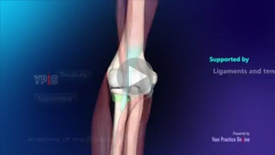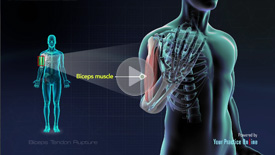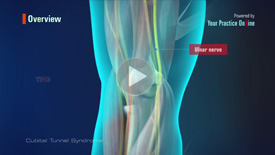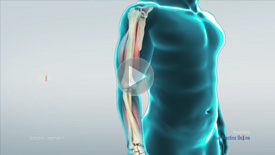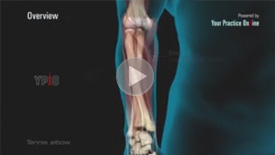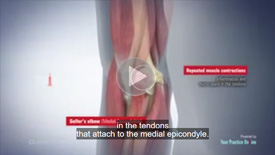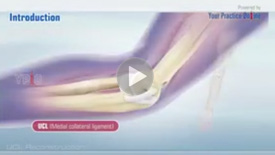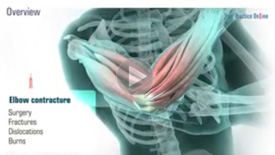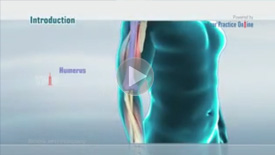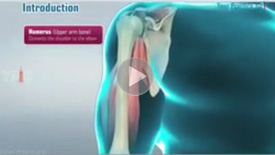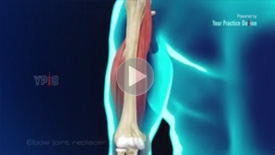Elbow
Elbow Anatomy
The elbow is a complex joint formed by the articulation of three bones –the humerus, radius and ulna. The elbow joint helps in bending or straightening of the arm to 180 degrees and assists in lifting or moving objects. Read More
Conditions
Bicep Tendon Tear at Elbow
The biceps muscle, located in the front of the upper arm allows you to bend the elbow and rotate the arm. Biceps tendons attach the biceps muscle to the bones in the shoulder and in the elbow. Read More
Ulnar Nerve Entrapment (Cubital Tunnel Syndrome)
The ulnar nerve travels down the back of the elbow behind the bony bump called the medial epicondyle, and through a passageway called the cubital tunnel. The cubital tunnel is a narrow passageway on the inside of the elbow formed by bone, muscle, and ligaments with the ulnar nerve passing through its center. Read More
Elbow Sprain
Elbow sprain is an injury to the soft tissues of the elbow. It is caused due to stretching or tearing (partial or full) of the ligaments which support the elbow joint. Ligaments are a group of fibrous tissues that connect one bone to another in the body. Read More
Tennis Elbow
Tennis elbow is the common name used for the elbow condition called lateral epicondylitis. It is an overuse injury that causes inflammation of the tendons that attach to the bony prominence on the outside of the elbow (lateral epicondyle). Read More
Golfer's Elbow
Golfer's elbow, also called Medial Epicondylitis, is a painful condition occurring from repeated muscle contractions in the forearm that leads to inflammation and microtears in the tendons that attach to the medial epicondyle. The medial epicondyle is the bony prominence that is felt on the inside of the elbow. Read More
UCL Sprain
The ulnar collateral ligament (UCL) is present on the inner side of the elbow and connects one of the forearm bones called the ulna to the upper arm bone called the humerus. It provides stability to the elbow, especially during overhead activities such as throwing. Read More
Elbow Dislocation
The elbow is a hinge joint made up of 3 bones - humerus, radius and ulna. The bones are held together by ligaments to provide stability to the joint. Muscles and tendons move the bones around each other and help in performing various activities. Elbow dislocation occurs when the bones that make up the joint are forced out of alignment. Read More
Elbow (Olecranon) Bursitis
The elbow contains a large, curved, pointy bone at the back called the olecranon, which is covered by the olecranon bursa, a small fluid-filled sac that allows smooth movement between the bone and overlying skin. Inflammation of this bursa leads to a condition called olecranon bursitis. Read More
Osteochondritis Dissecans
Osteochondritis dissecans is a joint condition in which a piece of cartilage, along with a thin layer of the bone separates from the end of the bone because of inadequate blood supply. The separated fragments are sometimes called "joint mice". Read More
Elbow Injuries
Fracture is a common injury to the elbow. Elbow fractures may result from a fall onto an outstretched wrist, a direct impact to the elbow or a twisting injury. Elbow fractures may cause severe pain, swelling, tenderness and painful movements. Read More
Little League Elbow
Little league elbow also called as medial apophysitis, is an overuse condition that occurs when there is overstress or injury to the inside portion of the elbow. It is commonly seen in children involved in sports activities that require repetitive throwing such as baseball. Read More
Nursemaid's Elbow
Dislocation of the radius bone present in the elbow is called nursemaid's elbow. This condition is very common among children below 5 years of age as their bones and muscles are still in the developing stage. Read More
Elbow Pain
The elbow is a hinge joint made up of 3 bones - humerus, radius and ulna. The bones are held together by ligaments to provide stability to the joint. Muscles and tendons move the bones around each other and help in performing various activities. Read More
Procedures
Total Elbow Replacement
Elbow Joint Replacement, also referred to as Total Elbow Arthroplasty is an operative procedure to treat the symptoms of arthritis that have not responded to non-surgical treatments. Read More
Elbow Arthroscopy
Elbow arthroscopy, also referred to as keyhole or minimally invasive surgery, is performed through tiny incisions to evaluate and treat several elbow conditions. Read More
Elbow Contracture
Elbow contracture refers to a stiff elbow with limited range of motion. It is a common complication following elbow surgery, fractures, dislocations, and burns. Read More
Elbow Ligament Reconstruction
The elbow is a complex joint of the upper limb formed by the articulation of the long bone of the upper arm or humerus and the two bones of the forearm, namely, radius and ulna. It is one of the important joints of the upper limb and is involved in basic movements such as flexion and extension of the upper limb and rotation of the forearm. Read More
Elbow Tendon & Ligament Repair
The elbow is a complex joint of the upper limb formed by the articulation of the long bone of the upper arm or humerus and the two bones of the forearm, namely, radius and ulna. It is one of the important joints of the upper limb and is involved in basic movements such as flexion and extension of the upper limb and rotation of the forearm. Read More
Fractures/Injuries
Elbow Fractures
Three bones, the humerus, radius and ulna, make up the elbow joint. Elbow fractures may occur from trauma, resulting from various reasons; some of them being a fall on an outstretched arm, a direct blow to the elbow, or an abnormal twist to the joint beyond its functional limit. Read More
Adult Forearm Fractures
The forearm is made up of 2 bones, namely, the radius and ulna. The primary function of your forearm is rotation i.e., the ability to turn your palm up and down. The fracture of the forearm affects the ability to rotate your arm, as well as bend and straighten the wrist and elbow. Read More
Forearms Fracture in Children
The radius (bone on the thumb side) and ulna (bone on the little-finger side) are the two bones of the forearm. Forearm fractures can occur near the wrist, near the elbow or in the middle of the forearm. Apart from this, the bones in children are prone to a unique injury known as a growth plate fracture. Read More
Distal Humerus Fractures of the Elbow
The elbow is a region between the upper arm and the fore arm. The elbow joint is made up of 3 bones. The distal (lower) end of the humerus bone in the upper arm joins with the radius and ulna bones in the fore arm to form the elbow joint. Read More
Elbow Fractures in Children
The elbow is a joint that consists of three bones - the humerus (upper arm bone), radius (forearm bone) and ulna (forearm bone). An elbow fracture most commonly occurs when your child falls on an outstretched arm. It can lead to severe pain in the elbow and numbness in the hand. Read More
Radial Head Fractures of the Elbow
The elbow is a junction between the forearm and the upper arm. The elbow joint is made up of 3 bones namely the humerus bone in the upper arm which joins with the radius and ulna bones in the forearm. The elbow joint is essential for the movement of your arms and to perform daily activities. Read More





